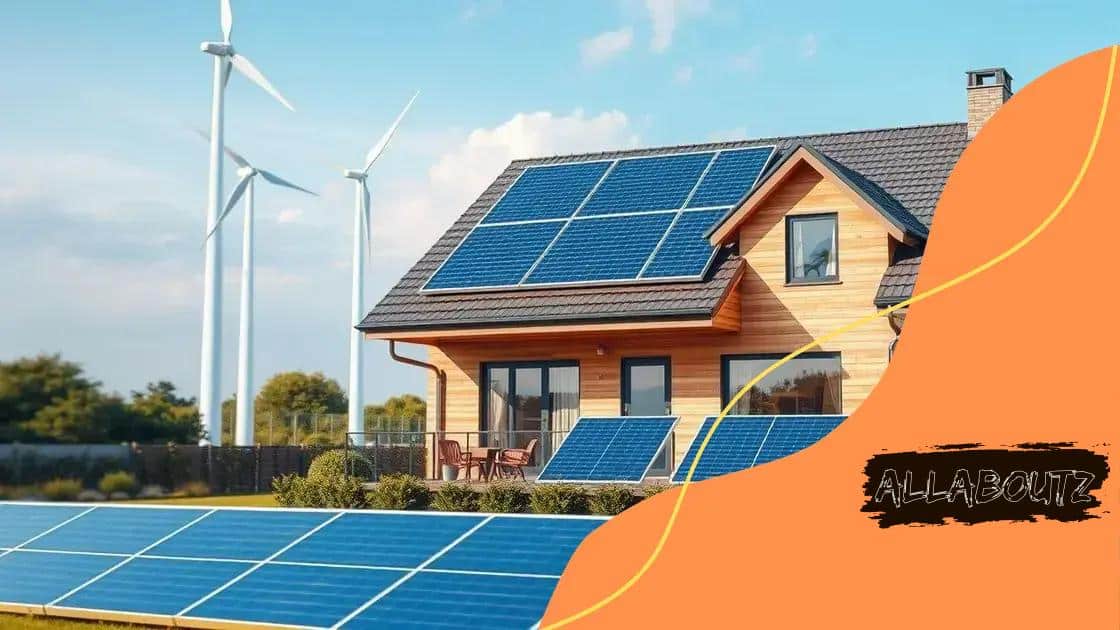Renewable energy incentives and rebates for homeowners

Renewable energy incentives and rebates for homeowners provide financial benefits such as tax credits and cash rebates, helping to reduce installation costs and promote sustainable energy usage.
Are you aware that renewable energy incentives and rebates for homeowners can greatly reduce your upfront costs? Today, many states offer programs that not only make green energy more accessible but also save you some cash in the long run. Let’s dive into how these incentives can benefit you.
Understanding renewable energy incentives
Understanding renewable energy incentives is crucial for homeowners looking to make smart energy choices. These incentives make it easier to adopt green technologies, ultimately benefiting both the pocket and the planet. By taking advantage of available programs, you can significantly reduce your installation costs.
What Are Renewable Energy Incentives?
Renewable energy incentives are financial benefits offered by the government or local authorities to encourage the use of eco-friendly energy sources. They can come in many forms, from tax credits to direct rebates. These programs aim to reduce the financial burden on homeowners transitioning to renewable energy.
Types of Incentives
- Tax Credits: These allow you to deduct a percentage of the installation cost of renewable energy systems from your federal taxes.
- Rebates: Direct payments or discounts provided after installation can significantly lower your initial investment.
- Grants: These are funds that do not need to be repaid, provided for specific energy projects.
- Low-interest Loans: Government-sponsored loans that make it easier to finance renewable energy systems.
Each type of incentive plays a unique role in encouraging homeowners to invest in renewable energy. For instance, tax credits can provide substantial savings during tax season, while rebates can give you immediate relief on upfront costs. Understanding different incentives helps you plan effectively for your energy needs.
Many states also have additional programs tailored to specific energy improvements. Checking local resources can help you tap into more savings. Some utilities even offer special programs that offer further incentives for energy efficiency upgrades.
Types of rebates available for homeowners
When exploring types of rebates available for homeowners, it’s important to understand that these incentives can vary widely. Each type aims to encourage energy efficiency and the adoption of renewable energy. Being aware of these rebates can help you save significant amounts on your energy upgrades.
Cash Rebates
Cash rebates are direct payments provided by utilities or local governments after the installation of renewable energy systems. They help to immediately reduce the cost burden on homeowners. These rebates can range from a few hundred to several thousand dollars, depending on the system installed.
Performance-Based Incentives
Performance-based incentives shift the payment structure from upfront rebates to ongoing payments based on the energy produced. For example, solar energy systems might earn a set amount for every kilowatt-hour generated. This approach can offer long-term savings for homeowners.
Utility Company Programs
- Energy Efficiency Rebates: These are offered for upgrading appliances, insulation, or windows to more energy-efficient models.
- Solar Panel Rebates: Many utilities provide financial assistance specifically for solar panel installations.
- Heat Pump Rebates: Rebates are often available for installing high-efficiency heating and cooling systems.
- Electric Vehicle Charging Station Rebates: Homeowners may receive incentives for installing charging stations in their garages.
Each utility company has specific programs, so checking with your local utility can unveil additional opportunities for rebates. Leveraging these programs not only aids in saving money upfront but also contributes to a sustainable lifestyle.
Another important type of rebate is the federal tax rebate, which allows you to deduct a portion of the cost of renewable energy systems from your federal taxes. Staying informed about these options ensures you can maximize your savings whenever you invest in green technology.
How to apply for energy incentives

Knowing how to apply for energy incentives can unlock significant savings for homeowners. The application process is often straightforward but requires attention to detail. Following the right steps can ensure you receive all the benefits available for renewable energy installations.
Research Available Programs
Your first step should be to research the programs available in your area. Different states and local utilities offer various incentives. Look into your city or state’s energy department website for updated information on what is available to you.
Gather Required Documentation
Before applying, gather all necessary documentation. This usually includes proof of installation, receipts for any work done, and possibly photos of the installation. Having these documents ready will streamline your application process. Additionally, make sure to keep copies of everything you submit.
Completing the Application
The application itself may vary depending on the program. Most applications will require basic information about yourself and your energy system. Be thorough and honest when filling out the application. Missing information could delay the process.
- Be Timely: Pay attention to application deadlines to ensure you don’t miss out.
- Check for Submission Methods: Some programs may require online submissions, while others might ask for mailed applications.
- Follow Up: After submission, check the status of your application. This helps identify any additional information required.
Many programs have a contact number or email for inquiries; don’t hesitate to reach out if you have questions. Understanding the specific requirements for each program can save you time and effort down the line.
Lastly, be patient. Processing times can vary, but you will receive notifications about the status of your application. Knowing that you’ve done your part will ease the wait as you anticipate your savings.
Maximizing savings with tax credits
Maximizing savings with tax credits is a smart move for homeowners who invest in renewable energy. Tax credits directly reduce the amount of tax you owe, making them different from deductions, which only reduce your taxable income. Understanding how these credits work can lead to substantial savings.
Types of Tax Credits Available
There are various tax credits related to renewable energy systems. Most significantly, federal tax credits allow you to claim a percentage of your installation costs when you file your tax return. These credits can apply to solar panels, solar water heaters, and even wind turbines.
Eligibility Requirements
To qualify for the credits, your system must meet certain criteria. Generally, the equipment should be new and installed at your primary residence. Check specific requirements for each type of credit to ensure eligibility.
- Installation Standards: Ensure that the equipment is installed by a qualified professional.
- Service Life: Equipment must have a significant lifespan to qualify for credits.
- Documentation: Keep all receipts and installation paperwork handy, as you will need them for your tax filings.
Claiming these credits can drastically reduce the net cost of your renewable energy investment. Besides federal tax credits, many states offer additional credits, which can further enhance your savings. These state-level incentives often vary significantly, so researching local programs can be beneficial.
Don’t forget to consult a tax professional when preparing your taxes. They can help you navigate the complex tax code and ensure that you are not missing out on potential savings. Filing your taxes accurately can optimize your benefits and keep unexpected issues at bay. Overall, taking advantage of tax credits is essential for reducing costs and maximizing your investment in renewable energy.
Future of renewable energy support for homeowners
The future of renewable energy support for homeowners looks bright as more individuals and families recognize the benefits of green energy solutions. As technologies advance and public interest grows, government and utility programs are expected to expand. Increased support means homeowners can enjoy greater savings and enhanced energy efficiency.
Potential Expansion of Incentives
More states are likely to introduce comprehensive legislation aimed at promoting renewable energy. Future incentives may include enhanced tax credits, increased rebates, and more accessible loan programs. This expansion will cater to a diverse range of energy solutions such as solar, wind, and energy-efficient home upgrades.
Innovative Technologies
New technologies will continue to shape the renewable energy landscape. Smart home systems that maximize energy efficiency will gain popularity. These technologies can lower utility bills while contributing to sustainability efforts. For example, advancements in battery storage will allow homeowners to store excess energy for later use, making energy consumption more efficient.
Community Programs
- Local Solar Co-ops: These groups allow homeowners to band together to purchase solar installations at reduced costs.
- Shared Renewable Energy Projects: Neighborhood projects can help provide renewable energy to multiple homes, making it more affordable.
- Workshops and Educational Resources: Local governments are likely to offer more programs to educate homeowners about renewable energy options and financial benefits.
Additionally, utility companies may enhance their green energy programs to meet regulatory requirements and consumer demand. Programs might become more tailored to individual needs, providing personalized recommendations based on a home’s energy use and potential upgrades.
As more homeowners take advantage of these incentives, there will be a ripple effect promoting wider adoption of renewable technologies. This collective effort will drive demand for further innovations, making renewable energy even more accessible.
In conclusion, the journey toward adopting renewable energy is both rewarding and essential for homeowners today. Various incentives, including rebates and tax credits, make it easier than ever to opt for sustainable energy solutions. Understanding the available programs will help homeowners save money while contributing to a cleaner environment. The future looks bright with ongoing support and advancements in technology, making renewable energy choices more accessible. By staying informed and proactive, homeowners can maximize their savings and play a vital role in promoting a greener planet.
FAQ – Questions Frequently Asked About Renewable Energy Incentives for Homeowners
What are renewable energy incentives?
Renewable energy incentives are programs that provide financial benefits to homeowners for using green energy solutions, such as tax credits and rebates.
How can homeowners maximize their savings with these incentives?
Homeowners can maximize their savings by understanding the available incentives, keeping all necessary documentation, and applying for tax credits and rebates.
What types of tax credits are available?
There are various tax credits, including those for installing solar panels, energy-efficient appliances, and other renewable energy systems.
How do I apply for energy incentives?
To apply, research available programs, gather required documentation, and complete the application accurately before submission.





